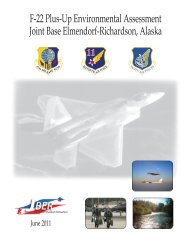PSDM 09-31 OS Returnee Counseling Handoout
PSDM 09-31 OS Returnee Counseling Handoout
PSDM 09-31 OS Returnee Counseling Handoout
You also want an ePaper? Increase the reach of your titles
YUMPU automatically turns print PDFs into web optimized ePapers that Google loves.
call toll free by using a toll-free AT&T direct access number from the country you are in, then<br />
800-616-3775, option 1. AT&T direct access numbers can be obtained from<br />
http://www.business.att.com/bt/dial_guide.jsp to update your assignment preferences.<br />
c. <strong>Returnee</strong> Assignment Priority. To give you a better understanding on your assignment<br />
priority, the following information is provided: Before CONUS assignments are matched,<br />
overseas returnees are aligned into three groups within each grade and AFSC, and then further<br />
grouped by number of short-tours and extensions. This grouping determines your selection<br />
priority.<br />
(1) Group one (highest priority) are those returning from overseas tours of 17 months or<br />
less where dependents are restricted.<br />
(2) Group two are those returning from overseas tours of 17 months or less where<br />
dependents are authorized, but the member served unaccompanied.<br />
(3) Group three (lowest priority) are those returning from overseas tours of 18 months or<br />
more, regardless of accompanied status.<br />
Each returnee is aligned within these three groupings based on the number of short tours<br />
previously served (this doesn’t count your current tour). Those having the most short tours<br />
receive higher priority.<br />
When the number of short tours is equal for two or more returnees, higher priority within each<br />
group is given to those who extended at least six months in a short tour area or 12 months in a<br />
long tour area. Additionally, each month you extend beyond the 6 or 12 month minimum raises<br />
your priority. If ties still exist within a group, they are broken down by Date of Rank and Total<br />
Active Federal Military Service Date. After the grouping is complete, the assignment match<br />
process begins accordingly. For officers (Lt Cols and below), a combination of factors such as<br />
the ADP, DT vectors, and current PCS location determine an officer’s next PCS. The returnee<br />
assignment priority does not apply to colonels and selectees.<br />
6. Special Duty Assignment Consideration (EQUAL-Plus) (Enlisted Only).<br />
EQUAL-Plus is a listing containing requirements by grade and AFSC for special duty<br />
assignments, Joint/Departmental assignments, chief master sergeant assignments, and short<br />
notice requirements. The EQUAL-Plus Listing is updated daily and may be accessed in the<br />
Assignment Management System (AMS) via the AFPC Secure website:<br />
https://www.afpc.randolph.af.mil/afpcsecure. If you wish to apply for a special duty, you may<br />
apply after your ASD; however, you will only be considered if there are no other qualified<br />
volunteers. Assignment selection will be after the volunteer-by date has expired. You may<br />
volunteer for another assignment if the MPS has not notified you of selection within 45 days after<br />
the volunteer-by date. You may volunteer for only one special duty at a time.<br />
Eligibility requirements are listed in AFI 36-2110 and specific qualifications are shown in the<br />
advertisement or on the Special Duty Catalog (SPECAT) Assignment Guide located at the MPS or<br />
online at<br />
https:/afpc.randolph.af.mil/Docs/DPA/AssignProc/SPECAT/SPECATASSIGNMENTGUIDE.DO<br />
C. Overseas personnel may apply for special duties if the reporting date is during the DER<strong>OS</strong>
















